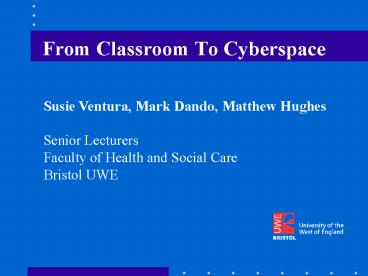From Classroom To Cyberspace - PowerPoint PPT Presentation
1 / 16
Title:
From Classroom To Cyberspace
Description:
Biggs and constructivism. To incorporate constructive alignment. A series of tasks to: ... The underpinning pedagogy, that of constructivism, ... – PowerPoint PPT presentation
Number of Views:49
Avg rating:3.0/5.0
Title: From Classroom To Cyberspace
1
From Classroom To Cyberspace
Susie Ventura, Mark Dando, Matthew Hughes Senior
Lecturers Faculty of Health and Social Care
Bristol UWE
2
CONTEXT
- New Undergraduate pre - qualifying framework
for all professional programmes - Within each year of these three yearprogrammes
is an inter professional module accessed by all - Each inter professional module employs an
enquiry based learning model
3
The online module
Inter professional level 3
- Caters for most professional groups
- Runs twice a year
- Accessed by 700 students
4
Staff Team
- Total of 21 staff represent all professions
- 60 of staff had no previous experience of
online delivery - 90 of staff experienced lecturers and played an
active role in IP modules in years one and two - Committed, enthusiastic and worked well together
5
Students
- Less enthusiastic and very nervous
- Anxiety not appreciated by staff
- For most excitement replaced anxiety
- For some discomfort with VLE or
technologyremained throughout module
6
Rationale for online delivery
- Previous experience of using a VLE as resource
and discussion forum - Identification of learning opportunities medium
offered, but not exploited - IP module would enable us to explore different
learning and teaching approaches - Accommodation of expanding student population
provided added benefit - Greater flexibility for students
7
Learning opportunities
- Extending knowledge and understanding by
gathering and sharing information - Learning from and with each otherdevelopment of
academic skills - Shifting the focus from teaching to learning
- Promotion of reflection and critical thinking
8
Ideas for the design
- Essential that students engaged in learning
- Review of underpinning pedagogy
- Biggs and constructivism
- To incorporate constructive alignment
9
A series of tasks to
- Maintain interest and focus
- Build on knowledge and experience
- Develop new skills
- Review learning
10
Activities and assessment
- These addressed the four learning outcomes
- and included
- Two briefing papers
- Design of a group critique framework
- Peer Critiquing by collating and evaluating
comments from peers producing feedback - A reflective account of their experiences
11
Staff development issues
- Facilitation skills online different to
F2F-recognising when to intervene - Staff feeling less than confident working in this
new environment - permanence of replies - Organisation of time, access , workloads
12
Competencies for facilitators
- Those identified by Salmon (2000) adapted
- and utilised as below
- Stage 1 Access and motivation
- Stage 2 Online socialisation
- Stage 3 Information exchange
- Stage 4 Knowledge construction
- Stage 5 Development
13
IT Factors
- Students lack of IT skills and fear of
computers - Peer support from more competent students
- Access to computers off campus
- IT skills increased during delivery
- Infrastructure, admin, reliable platform
14
Asynchronous discussion
- Impact on communication style Encourages
considered and reflective responses - Frustrating waiting for responses
- Space to think
- Increased confidence and participation for some
- Chat room discussions more chatty but ?
encouraged group cohesion - Group processes mirrored those in F2F interactions
15
Conclusion
The underpinning pedagogy, that of
constructivism, could be utilised across all
learning whether online or F2F. Experience
suggests that there are advantages of online
learning when adopting this approach
particularly in respect to encouraging
reflection and critical thinking. The environment
also promotes collaboration and as
all discussions are saved students have the
opportunity to review their contributions and
learning. Finally it is becoming increasingly
difficult to engage students in deep learning
when class sizes are so large this environment
provides the opportunity to probe, challenge and
enrich the experience.
16
Further reading
Suggested further reading Biggs J (1996)
Enhancing teaching through constructive
alignment Higher education 32 347 364 Bruner J
S (1986) Actual minds, possi1ble worlds.
Cambridge MA Harvard University Press Driscoll
M P (1994) Psychology of learning for
instruction. Boston Allyn and Bacon Fisher K,
Phelps R, Ellis A (2000) Group processes
online teaching collaboration through
collaborative processes Educational Technology
Society 3 (3) Palloff R Pratt K (1999) Building
learning communities in cyberspace effective
strategies for the online classroom. San
Francisco Jossey - Bass Rourke I Anderson T,
Randy garrison D Archer W (1999) Assessing
social presence in asynchronous text based
computer conferencing Journal of Distance
Education 14 92) 50-7 Rust C (2000) The impact
of assessment on student learning Active
learning in higher education Vol3 (2) 145 -
158 Salmon G (2000) E-moderating The key to
teaching and learning online London. Kogan Page

